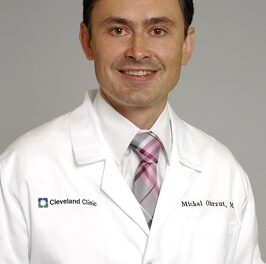|
The team who made this first procedure possible (l-r) Dr. Georges Hatoum, Radiation Oncologist; Dr. Beth-Ann Lesnikoski, Breast Surgeon; Dr. Robert Gardner, Breast Surgeon; Dr. Xiaodong Wu, Radiation Physicist; and Dr. Yi Zheng, Radiation Physicist.
|
JFK Medical Center is the first hospital in the United States to perform Electron Intraoperative Radiation Therapy (e-IORT) on a new technology called LIAC 12 from SIT, USA. This new procedure can essentially reduce breast cancer treatment from six and a half weeks to one day for many women.
Advances in surgery and radiation therapy make breast cancer treatments safer and more convenient than ever before. Standard radiation therapy usually involves as many as 33 treatments given five days per week. With e-IORT JFK’s radiation oncologists can deliver an equivalent dose of radiation in a “single fraction” or treatment session lasting just a few minutes, while also preserving more healthy tissue. This electron-based treatment reduces radiation exposure and its side effects, as well as the time spent going back and forth to the hospital for such treatments.
E-IORT is a practical and safe alternative to standard whole breast radiation therapy for many patients. It is administered to the inside of the breast during surgery, immediately after removal of the cancer. For many patients, after awakening from anesthesia, both the breast surgery and radiation therapy are completely done. Most eligible patients won’t need to undergo any additional radiation therapy. The remaining patients still benefit from e-IORT as a “boost” during surgery followed by 3 to 5 weeks of external beam radiation therapy.
“This technology benefits so many women. I see it really benefiting the busy professional, working moms, and older women with transportation issues,” said Dr. Beth Lesnikoski, Breast Surgeon and Medical Director at The Breast Institute at JFK Medical Center. “e-IORT has the potential to significantly lower healthcare costs. Not only is it a safe alternative to weeks of external radiation, but it also reduces damage to skin, ribs and chest muscles, and perhaps even the underlying heart and lungs.”, explains Dr. Lesnikoski.
A patient must be a surgical candidate in order to be eligible for e-IORT. This treatment is generally reserved for individuals with early-stage disease with these patients comprising upwards of 30 percent of all patients diagnosed. Your doctor will discuss whether e-IORT is an appropriate treatment option for you, based on your individual diagnosis, tumor characteristics, and personal preference.
E-IORT is not only more convenient, it is also effective at reducing the risk of cancer recurrence. Since it is administered to the inside of the breast rather than through the skin, e-IORT reduces radiation side effects on the breast skin. A shield is placed underneath the breast during treatment to protect the underlying structures including heart, lungs and ribs. E-IORT with SIT, USA’s LIAC 12 technology has been the centerpiece of multiple studies over both a 5 and 10 year period and has been approved by the FDA.
“E-IORT allows the delivery of a powerful dose of radiation at the time of surgery to any microscopic or residual tumor that may still be present after the removal of all the tumor, by the breast surgeon. E-IORT is focal radiation therapy where you have direct visualization of the tumor or tumor bed allowing for the delivery of a higher dose of radiation while excluding sensitive normal tissues and thus increasing the potential for increased tumor control”, explains Dr. Georges Hatoum, Radiation Oncologist and Medical Director of the JFK Comprehensive Cancer Institute.
SIT, USA’s LIAC 12 technology uses electrons to deliver radiation precisely to the area of the breast where the tumor was removed during surgery. Electrons have been shown to be highly effective in reducing the radiation risk or toxicity to the surrounding normal tissue. Other benefits of e-IORT delivered by the LIAC include the ability to treat deeper tumors and a wider variety of breast sizes and tumor locations, a significant reduction in on-beam time for the patient and the ability for the technology to be used for many cancer sites other than breast cancer.




























